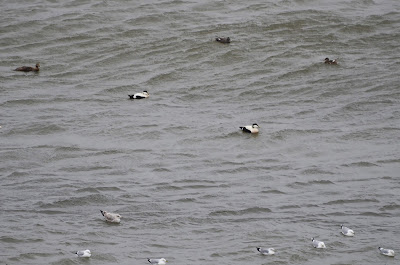What a year 2013 was for me on Patch – I
absolutely smashed my record species count by 7, found 6 bonus point scoring
species, and even managed to add a couple of species of mammals! Here’s a
breakdown of how it went, month by month
January
I picked up 63 species in January – not a
bad total for me, and including some goodies such as little auk, waxwing,
black-throated diver and chiffchaff – my first record of an overwintering bird
on patch. Other species that can prove awkward over the course of the year
included coal tit and short-eared owl.
February
I only added 5 species in February, and
even at that early stage it seemed like the wheels might have come off any
attempts at a high total. Among them
were Mistle thrush, which is less than annual, and stock dove, which I have
only recorded twice before.
March
Things picked up considerably in March,
seeing a total of 11 additions to the species list, with some nice little bits
of quality in the form of glaucous gull, Slavonian grebe and snow bunting. Cream
of the crop though was a pair of Gadwall that briefly joined the eider flock in
the harbour – only my second record on patch. No sign of any spring migrants
though.
April
As per usual, April saw a surge in
additions to the patch year list, with returning migrants accounting for many.
20 new species were added, with highlights being collared dove, yellowhammer (less than
annual), tufted duck, Iceland gull, and little tern. Unusually, I also had my
only record of Minke whale in April, too.
May
Another good month, with 14 species added,
including a few good ones. I walked past a bluethroat mid month, which was a
bit of a downer, but luckily I caught up with the bird later in the day. I also
scored my first bonus points of the year with
red-backed shrike. On top of those, I had more interesting migrants such
as lesser whitethroat and whinchat.
June
Only two birds added in June – a crossbill
which gave amazing views, and a surf scoter, which gave less good views but was
only my second on patch, and was a cracking drake.
July
No additions whatsoever! And no interesting
cetaceans, which is a bit unusual…
August
August was when it all started to kick off.
I added 18 species to the year list. I
added several waders, including a green sandpiper that I picked up as if flew
past the office window! There were also falls of migrants that delivered pied and
spotted flycatchers, reed warbler, and some bonus points with wryneck, barred
warbler and a couple of greenish warblers. In spite of all this, August will
always be remembered as the month I got my first girdle ness killer whales…
September
September saw only 5 additions, possibly
because of two weeks away from home on Sanday. Best of the bunch were a couple
of yellow-browed warbler, but with a nice supporting cast of great crested
grebe and great spotted woodpecker, neither of which can be expected in any
year.
October
8 additions in October. A twitched shore
lark was bird of the month, but there was further quality added in the forms of
merlin, barnacle goose, tree sparrow, ring ouzel, and mealy redpoll. I also had an intriguing eastern lesser whitethroat...
November
2 species added, both wintery additions –
whooper swan and great northern diver. I also added a few extra points with a Siberian
chiffchaff. Great northern diver was the last addition to the list, leaving me
on a maximum break of 147 species and 217 points.
December
As I said above – no more additions, but
plenty of time to lament on what could have been – having missed tystie,
pomarine skua, both redstarts, long tailed skua, and quite a few more. At least
161 species were recorded, so breaking the 150 is definitely possible, and my
target for 2014. Bring it on!
Finally, here's a bit of patch geekery - my species and points accumulation plotted as graphs. Really shows year on year where the biggest leaps forward were made. First the species totals and then the points totals. It shows that in 2013, early autumn was the key time for me, as opposed to later autumn in 2011 and 2012 - although this perhaps reflects no more than when the best falls occurred. The graphs also show nicely that spring and autumn are the key times in all three years, with the lines being at their steepest then. Thats not to say that winter and summer aren't important of course...
There are three killer whale on the pic - or at least there are three killer whale blows!
Finally, here's a bit of patch geekery - my species and points accumulation plotted as graphs. Really shows year on year where the biggest leaps forward were made. First the species totals and then the points totals. It shows that in 2013, early autumn was the key time for me, as opposed to later autumn in 2011 and 2012 - although this perhaps reflects no more than when the best falls occurred. The graphs also show nicely that spring and autumn are the key times in all three years, with the lines being at their steepest then. Thats not to say that winter and summer aren't important of course...
I only added one species to my overall patch list - greenish warbler, which took me on to a total of 188 species. I fared a little better with mammals though, adding killer whale (hoped for but not expected) and red squirrel (completely off the radar!) taking me up to 20 species of mammals! No obvious further additions (unless I get a bat detector!)
There are three killer whale on the pic - or at least there are three killer whale blows!



































